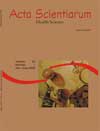<b>Prevalence of signs, symptoms and associated factors in patients with temporomandibular dysfunction</b> - DOI: 10.4025/actascihealthsci.v31i2.5920
Keywords:
epidemiology, temporomandibular joint dysfunction syndrome, myofascial pain syndromes
Abstract
This cross-sectional study evaluated the prevalence of signs, symptoms and associated factors in patients with temporomandibular dysfunction (TMD). The sample was composed of 40 patients aged 20 to 40 years. Data were collected using a form and were organized using Epi Info software. The existence of association among the variables was verified by Fisher’s Exact test (p < 0.05). The main complaints reported by patients were pain in the temporomandibular joint (TMJ) (45%) and muscular pain (12.5%). The most frequent signs and symptoms were TMJ noises (95%), TMJ pain (82.5%) and headache (77.5%). There was an association between the presence of myalgia and the occurrence of mouth opening limitation (p < 0.01) and between the presence of myalgia and the occurrence of mandibular deviation. All patients reported masticatory problems, among which were mentioned: unilateral mastication (77.5%), difficulty in chewing hard foods (70%), tiredness in mastication (55%), pain (47.5%) and mandibular locking (37.5%). There was a statistically significant association between unilateral mastication and mandibular deviation (p < 0.01) and between difficulty in chewing hard foods and mandibular deviation (p < 0.01). Parafunctional habits were present in 75% of patients, the most frequent being tooth clenching/grinding (55.5%) and lip/cheek sucking (35.5%). In conclusion, TMD patients present a high prevalence of signs and symptoms that are capable of directly affecting their quality of life, such as pain, mouth opening limitation and masticatory difficulties.Downloads
Download data is not yet available.
Published
2009-09-17
How to Cite
Figueiredo, V. M. G. de, Cavalcanti, A. L., Farias, A. B. L. de, & Nascimento, S. R. do. (2009). <b>Prevalence of signs, symptoms and associated factors in patients with temporomandibular dysfunction</b> - DOI: 10.4025/actascihealthsci.v31i2.5920. Acta Scientiarum. Health Sciences, 31(2), 159-163. https://doi.org/10.4025/actascihealthsci.v31i2.5920
Issue
Section
Dentistry Articles
DECLARATION OF ORIGINALITY AND COPYRIGHTS
I Declare that current article is original and has not been submitted for publication, in part or in whole, to any other national or international journal.
The copyrights belong exclusively to the authors. Published content is licensed under Creative Commons Attribution 4.0 (CC BY 4.0) guidelines, which allows sharing (copy and distribution of the material in any medium or format) and adaptation (remix, transform, and build upon the material) for any purpose, even commercially, under the terms of attribution.
Read this link for further information on how to use CC BY 4.0 properly.























5.png)







